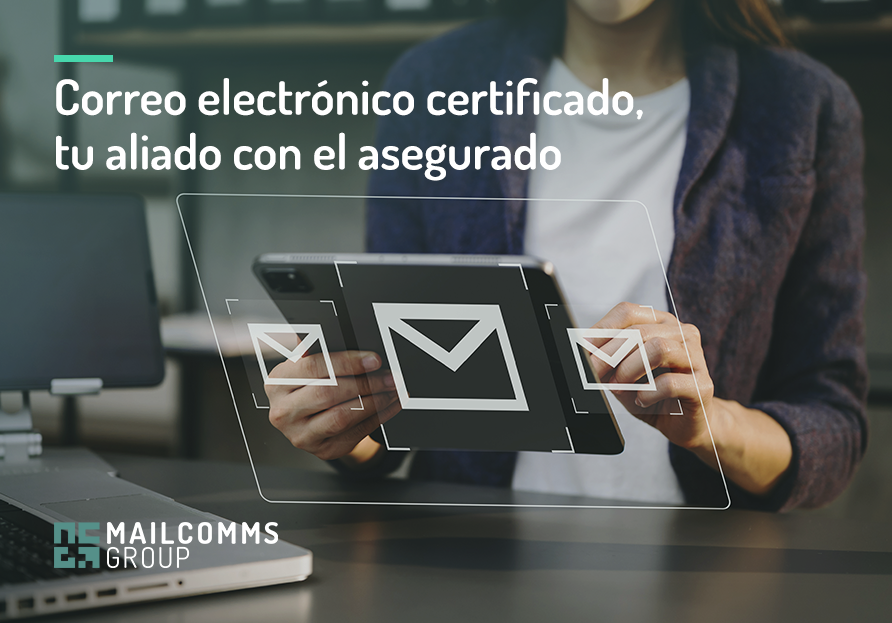
En un mundo cada vez más digitalizado, la comunicación en el sector asegurador experimenta una transformación importante gracias a la adopción del correo electrónico certificado. Enviar un e-mail certificado con validez legal ayuda a que las aseguradoras interactúen con sus clientes y otros actores de manera efectiva, fehaciente y personalizada.
A continuación, veremos cómo el correo electrónico certificado ha cambiado el panorama de la comunicación en seguros y por qué su adopción es cada vez más crucial para las empresas del sector. Descubre, además, cómo enviar correos electrónicos certificados de manera ágil, sencilla y con total fehaciencia legal.
Se podría decir que el email certificado tiene su reflejo en la versión certificada del postal. Conoce en este artículo las diferencias entre correo ordinario y certificado, y en este otro contenido cuándo es obligatorio para una empresa usar correos electrónicos certificados.
¿Qué es el correo electrónico certificado?
El correo electrónico certificado es una modalidad de e-mail que proporciona pruebas fehacientes de la entrega y el contenido de un mensaje. A diferencia del correo electrónico tradicional, un e-mail certificado incluye evidencias que pueden ser utilizadas legalmente para demostrar que un mensaje fue enviado y recibido, así como su contenido exacto.
Si comparamos un correo electrónico certificado con una carta postal certificada, el correo electrónico captura y aporta mayor volumen de evidencias, pues incluye también la certificación del contenido. Así pues, si comparamos ambos servicios, el e-mail certificado aporta inmediatez y facilidad de uso.
Además, el correo electrónico es clave a la hora de diseñar y ejecutar una estrategia mejorada de trazabilidad de documentos legales en aseguradoras.
El prestador cualificado y el correo electrónico certificado
 Para que un e-mail adquiera la cualidad de certificado tiene que ser enviado por un prestador de servicios de confianza cualificado en entrega electrónica, como lo son MailTecK y Customer Comms en el Grupo MailComms. Esta figura fue creada y regulada por el Reglamento UE 910/2014 del Parlamento Europeo y el Consejo de Europa, y se mantiene en su evolución conocida como eIDAS2.
Para que un e-mail adquiera la cualidad de certificado tiene que ser enviado por un prestador de servicios de confianza cualificado en entrega electrónica, como lo son MailTecK y Customer Comms en el Grupo MailComms. Esta figura fue creada y regulada por el Reglamento UE 910/2014 del Parlamento Europeo y el Consejo de Europa, y se mantiene en su evolución conocida como eIDAS2.
Para entender mejor su funcionamiento es importante conocer que el prestador de servicios de confianza cualificado actúa como un “notario digital”. Esto se traduce en que la aseguradora envía el e-mail certificado y personalizado a través de las plataformas securizadas del prestador cualificado, integradas o no en sus sistemas, que capturan las evidencias de la comunicación celebrada entre la aseguradora y su usuario.
Con la captura de estas evidencias y la certificación por el prestador, la compañía obtiene un certificado válido que puede utilizar en sede judicial para proteger, si es necesario, sus intereses en posibles litigios, ya que acredita que la comunicación sucedió y lo hizo de la forma que se prueba: con un contenido determinado y con interacciones, o no, por parte del receptor.
Ventajas del correo electrónico certificado en el sector de seguros
Validez legal y seguridad
Una de las principales ventajas del correo electrónico certificado es su validez legal. Esto es crucial en el sector seguros, donde la comunicación precisa y verificable es esencial.
Desde la emisión de pólizas hasta la gestión de reclamaciones, enviar un e-mail certificado asegura que las comunicaciones importantes están debidamente registradas y pueden ser presentadas como evidencia en caso de disputas legales.
No es fácil que un correo electrónico certificado alcance la misma robustez legal que un burofax online certificado (que es un medio oficial y reconocido por los tribunales en España). Pero es cierto que, dependiendo de la relevancia de la comunicación que se tiene que realizar, este medio puede ser más que suficiente, con la normativa y la jurisprudencia en la mano. Es decir, la validez de las comunicaciones por correo electrónico, legalmente hablando, depende de que se que se envíen a través de un proveedor capaz de remitirlo de manera certificada.
Reducción de costes, eficiencia y sostenibilidad
Certified e-mail also offers a significant cost reduction compared to traditional methods of communication. Sending a certified e-mail is cost-effective and almost instantaneous. This not only reduces insurers’ operating expenses, but also improves efficiency in process management, enabling faster response to customer needs. In addition, it helps companies meet their environmental objectives, which, in turn, provides an image often desired by their customers.
Mejora de la experiencia del cliente
La rapidez y la seguridad del correo electrónico certificado contribuyen a una mejor experiencia del cliente. En un sector donde la confianza y la transparencia son fundamentales, enviar y recibir comunicaciones de manera inmediata y segura mejora la percepción que los clientes tienen de la aseguradora. Los clientes pueden recibir sus pólizas, avisos de vencimiento y resoluciones de reclamaciones de manera rápida y confiable y esto incrementa su satisfacción y fidelidad.
 Al igual que en otras industrias, y más aún en aquellas que están muy reguladas, una experiencia de cliente positiva viene muy influenciada por la omnicanalidad. Esto es especialmente relevante en el sector asegurador, donde una gran parte de sus clientes son seniors que no se sienten del todo cómodos en el mundo digital. Las tecnologías que aúnan diferentes canales digitales y físicos de manera natural son esenciales, por tanto, para integrar o, dicho de otra manera, no excluir a ciertos colectivos. En este punto entran en juego conceptos como phygital o human insurance, con los que en Grupo MailComms estamos muy comprometidos.
Al igual que en otras industrias, y más aún en aquellas que están muy reguladas, una experiencia de cliente positiva viene muy influenciada por la omnicanalidad. Esto es especialmente relevante en el sector asegurador, donde una gran parte de sus clientes son seniors que no se sienten del todo cómodos en el mundo digital. Las tecnologías que aúnan diferentes canales digitales y físicos de manera natural son esenciales, por tanto, para integrar o, dicho de otra manera, no excluir a ciertos colectivos. En este punto entran en juego conceptos como phygital o human insurance, con los que en Grupo MailComms estamos muy comprometidos.
Además, si tenemos en cuenta que un mismo asegurado puede querer comunicarse a través de distintos canales en cada momento (e-mail, sms, WhatsApp…), contar con sistemas que permitan cambiar el canal de la comunicación sin perder su traza y certificarla finalmente es cada vez más necesario para ofrecer una experiencia multicanal real.
Integración con sistemas de gestión
Certified email is easily integrated with insurance management systems (EMS), facilitating process automation and centralized management of communications. This integration allows insurers to maintain a detailed and organized record of all certified communications, simplifying auditing and compliance.
Casos de uso del correo electrónico certificado en seguros
Como anticipábamos, la necesidad o no de certificar una comunicación depende de la relevancia, el compromiso y el riesgo que esta tenga para la aseguradora. No obstante, en un sector hiper regulado, como es el asegurador, y ante la creciente protección de los derechos de los asegurados, este tipo de comunicaciones son cada vez más necesarias para demostrar, sin fisuras, el correcto cumplimiento normativo.
Es decir, certificar una comunicación evita riesgos legales y protege, por tanto, los intereses económicos de las seguradoras.
A continuación, mostramos algunos ejemplos de uso del E-Mail certificado en el sector:
Emisión de pólizas
One possible use of certified e-mail in the insurance industry is the issuance of policies for certain highly critical lines of business. Sending a certified e-mail when issuing a policy ensures that the customer receives the document in its entirety and in the correct format, with the possibility of verifying delivery and content.
Gestión de reclamaciones
La gestión de reclamaciones, incluidos los impagos, es otro ámbito donde el correo electrónico certificado muestra su utilidad. Enviar comunicaciones certificadas durante el proceso de reclamación asegura que todas las partes están informadas de los pasos y decisiones tomadas, lo que reduce el riesgo de malentendidos y disputas.
También puedes reclamar a su seguro de hogar a través de estos canales. Te ofrecemos un modelo de carta para reclamación de daños al seguro de hogar para tu empresa.
Notificaciones de vencimiento y renovaciones
Policy expiration and renewal notifications also benefit greatly from certified email. Insurers can send reminders and renewal notices quickly and reliably, and can ensure that the notification has been received and collect evidence of interaction from recipients, if this occurs.
Notificación de indemnización en caso de siniestro
El e-mail certificado puede ser también una buena fórmula para notificar al asegurado la cuantía estimada que recibirá en concepto de indemnización por un siniestro cubierto en su póliza.
Desafíos y otras consideraciones
 A pesar de sus numerosas ventajas, la adopción del correo electrónico certificado también presenta desafíos. La seguridad cibernética es una preocupación importante, ya que la información sensible debe ser protegida contra accesos no autorizados y ciberataques. Las aseguradoras deben implementar robustos sistemas de seguridad y estar al tanto de las normativas vigentes en materia de protección de datos.
A pesar de sus numerosas ventajas, la adopción del correo electrónico certificado también presenta desafíos. La seguridad cibernética es una preocupación importante, ya que la información sensible debe ser protegida contra accesos no autorizados y ciberataques. Las aseguradoras deben implementar robustos sistemas de seguridad y estar al tanto de las normativas vigentes en materia de protección de datos.
Además, la adopción de nuevas tecnologías requiere formación y adaptación por parte del personal. Las aseguradoras deben invertir en capacitación para asegurar que sus empleados comprendan y utilicen eficazmente el correo electrónico certificado.
En este sentido, la figura de un prestador cualificado también se convierte en un aliado para garantizar los más altos niveles de seguridad posibles, al mismo tiempo que ofrece agilidad para adecuar los sistemas y las tecnologías a la rápida evolución de los ciberriesgos (y las capacidades de los ciberdelincuentes).
> Descubre cómo reducir costes operativos con la digitalización de comunicaciones legales.
> Conoce como evitar riesgos legales en contratos bancarios mediante comunicaciones fehacientes.
> Más información sobre cómo garantizar la validez legal de las comunicaciones con clientes en el sector asegurador.
